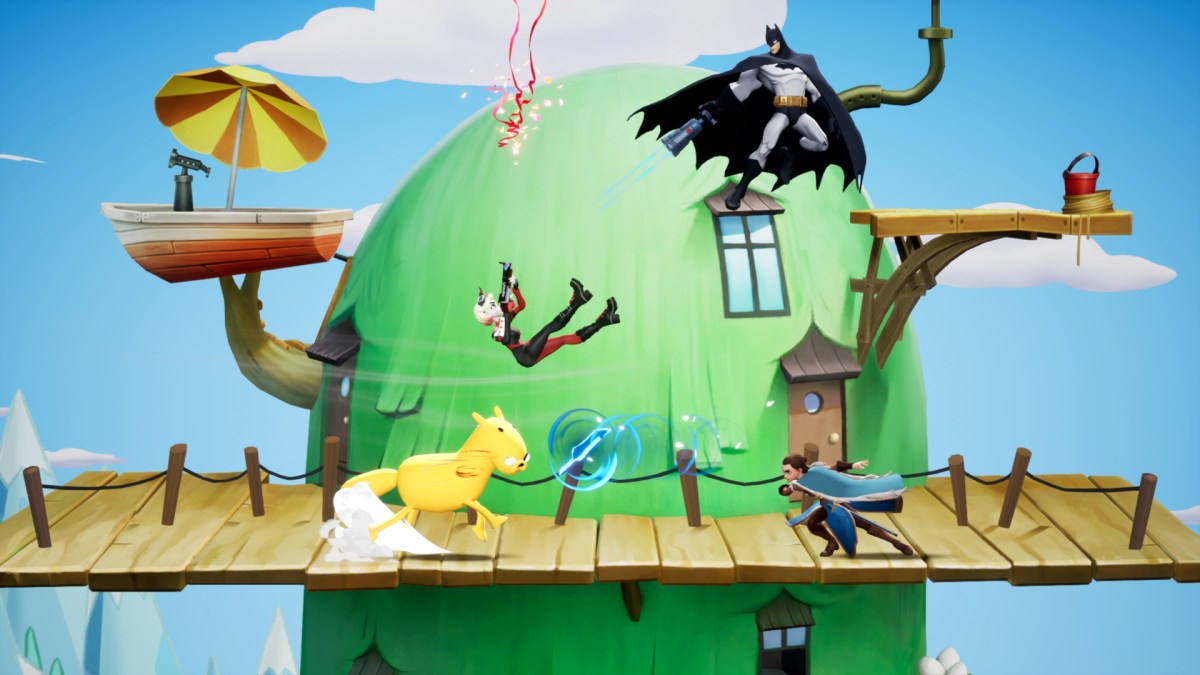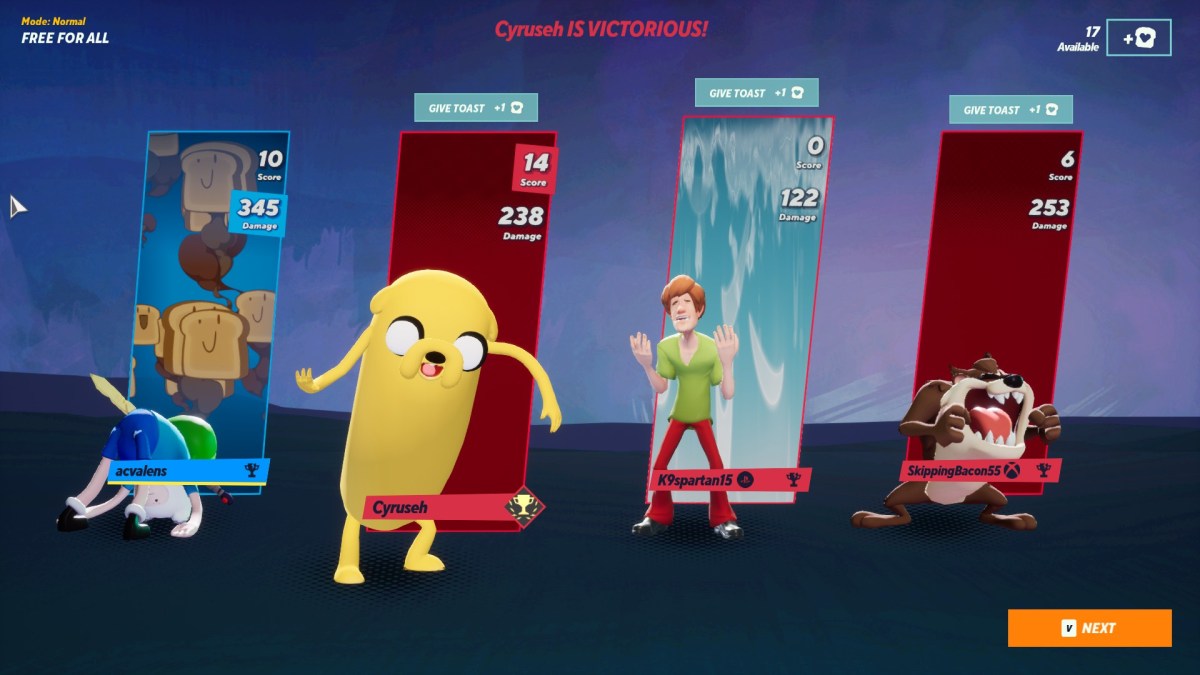It’s Cool That ‘MultiVersus’ Lets Me Beat Up Steven Universe. But I’m Not Sold Quite Yet
Steven, no!

Over the past few years, a couple developers have come along and tried to create their own take on the Super Smash Bros. fighting game formula. It’s been pretty great to see, but the whole experience has been admittedly hit and miss.
Sony tried it in 2012 with PlayStation All-Stars Battle Royal, but the company’s Smash-like never really caught on. Then Brawlhalla and Rivals of the Aether popped onto the scene in 2014 and 2015, followed by Ludosity’s PC platform fighter Slap City in 2017. The latter gained such critical acclaim that Ludosity later partnered up with Fair Play Labs on Nickelodeon All-Star Brawl. And now we have Warner Bros.’ own take on the Smash formula with MultiVersus, which just entered open beta this week.
MultiVersus takes characters from across the Warner Bros. universe and throws them all together into one big brawler. There’s Shaggy from Scooby Doo, Harley Quinn and Wonder Woman, Bugs Bunny, the Iron Giant, Adventure Time’s Finn and Jake, and, yes, Steven Universe himself. Even Game of Thrones makes an appearance via fan-favorite Arya Stark, which begs the question whether other live-action or adult-oriented Warner Bros. properties will enter the scene. Jules Vaughn and Rue Bennett vs. Orel Puppington and Pickle Rick, anyone? The possibilities are endless.
How is MultiVersus different?
It’s already very amusing to watch Superman beat up Steven Universe until he falls to his untimely demise. Sorry Steven, you’re just no much for the most powerful Gem of all: Clark Kent. And if you’re looking for a casual brawling experience with these bizarrely hilarious match-ups, MultiVersus delivers.
MultiVersus is doing something a little unique in the platform fighting game genre. Instead of trying to trick out Velma or Steven Universe with a moveset that turns them into a Batman-esque badass, each player character has their own in-game role. Velma is a Support that weakens enemies, buffs her allies’ attacks, and slows down other fighters. Wonder Woman stars as a Tank that can offer armor to her fellow fighter. Steven can send out Watermelon Stevens to do battle and heal his teammate. Everyone can still pack a punch regardless of their role, and you can theoretically take every character into a 1v1 battle and match them up against each other. But MultiVersus really stands out via its two-on-two Team mode, where random players join together and brawl until the first team hits four “ringouts” (or KOs). That’s where the role-based system shines the most, during collaborative play.
There are other changes from the more traditional Smash formula, too. Every character has special abilities that either charge up or have a cooldown. Finn has a killer high five that can knock highly damaged players out of the arena. Velma can throw a beaker on the ground and freeze enemies. Wonder Woman’s Lasso of Truth can draw allies or enemies closer to her, or she can take a Signature Perk that can knock her opponents off their feet. But unlike Smash, All-Star Brawl, or Slap City, a fair amount of your moves have cooldowns. You’ll have to track these timers mid-battle and deploy your special moves carefully, lest they disappear when you need them most. There’s truly nothing more frustrating than watching your ally die a needless death because you used your lasso at an inopportune moment.
Role and cooldown system aside, MultiVersus should feel very familiar to any Smash fan. Hit other enemies as many times as you can until they’re knocked out of the level, avoid getting hit yourself by any means possible, dodge and block attacks while punishing foes that overextend, rinse and repeat until you win (or lose). Multiplayer even uses rollback netcode, the gold standard in online fighting games, which assures relatively minor lag won’t necessarily affect multiplayer gameplay. Theoretically, anyway.
Is MultiVersus worth it?

There’s something so beautifully simple about Slap City and Nickelodeon All-Star Brawl. As soon as you fire up either game, you have everything you need to play. It takes just an afternoon to figure out the game’s controls and pacing, and in many cases, you can even learn new characters on the fly. They’re both literally pick-up-and-play fighting games.
MultiVersus isn’t hard to learn either, and it’s already far more popular than Slap City or All-Star Brawl. It’s easy to see why. In terms of music, sound, voice acting, and character design, it feels very polished, far more than Nickelodeon’s crossover offering. The transition to 3D for Finn, Jake, and Shaggy is quite seamless, whereas SpongeBob and XJ-9 look a little uncanny in Ludosity’s Nickelodeon crossover brawler.
But there are a lot of small things about MultiVersus that weigh down Warner Bros.’ crossover fighter. For one, MultiVersus gives players decent control over their fighters, but it’s a relatively slower game. Gravity is relatively low, and characters can feel downright sluggish at times, which means combat can be far more punishing. Movement is precise, but not quite as tight as it is in Smash. It’s not terrible, in fact, it’s not even that bad. The game plays fine for the most part, and it never feels like the player has to wrestle control from the game. But MultiVersus certainly lacks the finer polish over moves and controls that Smash provides.
Then there’s the in-game role system. It’s a neat idea in theory, but in practice, it only really works well in Team match-ups. If you pick Velma to play against Finn in a 1v1 match, there’s a very high chance the latter is going to come out on top. Finn is a fast, aggressive fighter built for sustained damage output, whereas Velma exists to setup plays for her teammate and provide buffs, nerfs, and support damage largely from afar. Velma is no pacifist, sure, but picking her in this mode puts the player at an automatic disadvantage.

The cooldown ability system also means Support characters can use up the lion’s share of their specials and attacks all at once, which is a relatively annoying experience in a game about hitting things. No one wants to sit around dodging enemies until they can pack a punch again. Even in Teams, you’re far more likely to match up with random players who pick aggressive, offense-based characters as a result, such as Shaggy, Batman, Jake, Wonder Woman, or Finn — which are generally far more fun to play in a game where the player’s main goal is to fight other players anyway.
This problem becomes even more pronounced in free-for-all, where four players go up against each other to get as many ringouts as possible. A killer Velma player could theoretically outmaneuver an above-average Finn on 1v1, but it’s far less likely that Velma will ever win a match in a game mode that requires one ringout after another. Given MultiVersus only has three modes, and two of them are non-team based, the game’s bustling crossover roster suddenly becomes relegated to all its offense-based fighters very quickly.
By the way, the game is online-only for now, as even player-vs-AI matches need you to connect to a game server. Network issues are not uncommon, even if the game’s rollback netcode prevents laggy matches from spiraling into despair. Content moderation for names is lacking too; there’s nothing more uncomfortable than seeing the names “Puseay Fart” and “HarryPenus” flash onscreen in a game marketed to young players. And much has been said about the microtransaction-heavy MultiVersus unlock system. Sure, MultiVersus is a free-to-play fighter, but expect to grind a lot of matches to unlock the entire character roster. Or failing that, be prepared to shell out some cash for in-game currency, if not purchasing one of the game’s many founder’s packs (which range from $39.99 to a heart-stopping $129.99, depending on your platform).
By the way, unlocking a character is just the start. After you’ve unlocked them, players have to grind out character-specific “perks” for a minimal (but non-negligible) advantage on the battlefield. Play enough as your new character, and you’ll unlock your first Signature Perk, which gives you an advantage over opponents with the same character who haven’t quite grinded out as many matches. Eventually, you can start taking other characters’ perks and using them on your chosen fighter.
Grind, grind, grind, this game should be called MultiGrind. Seriously, who wants to grind their way into playing a fighting game? Smash doesn’t force you to play several hours of Joker from Persona 5 to gain his full power on the battlefield. Once you unlock your character, you can just start training and practicing. The MultiVersus system’s perks essentially add a strategic layer that feels needlessly complicated for a fighting game. Just let me pick up and play, damnit.

Don’t get me wrong. There’s a lot of thought put into MultiVersus. It’s a clever idea with some really cool crossovers. Characters are easy to learn but difficult to master, and match-ups between offense-based characters rarely feel unfair. Every time I lost as Finn or Wonder Woman, I knew it was because I made a mistake, not the game. As a whole, MultiVersus is a game that will have you whispering “just one more match” until it’s 1am. I even lost track of time while writing this article because I couldn’t stop playing.
But when I think about fighting games, I tend to think about their long-term potential. Will MultiVersus drop off in a couple months, or will it be around for a year or two? I’m not so sure the latter will happen with all the free-to-play grindy nonsense and strange gameplay mechanics, even if the base combat is pretty fun. Eventually, knocking out the same three or four characters as the same three or four characters gets old, even if they’re as goofy in a fight as Finn or Shaggy.
(Featured image: Images via Warner Bros. Discovery, remix by Ana Valens)
Have a tip we should know? [email protected]